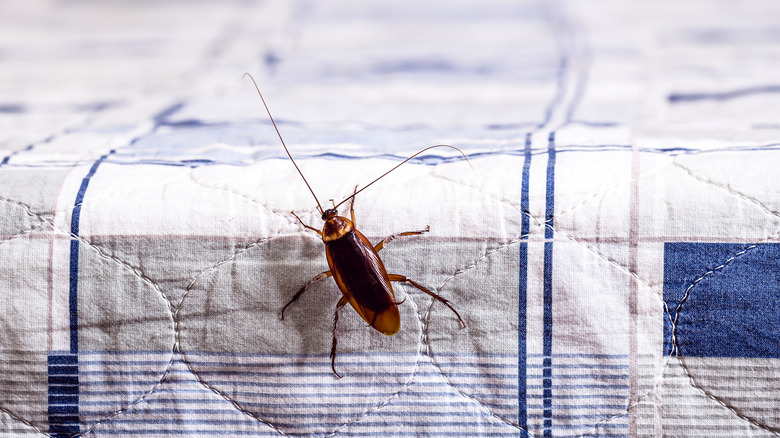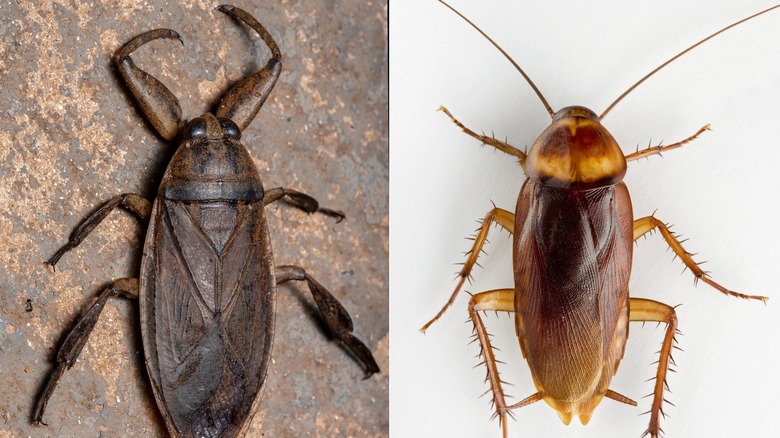Water Bug Vs Roach: How To Identify Which Creepy Crawler Is Invading Your Home
So, you're in your kitchen, and you spot a critter scurrying across the floor. Is it a water bug or a cockroach? Water bugs and cockroaches may seem similar in appearance, but they have distinct characteristics and habits that require different approaches to deal with them. Knowing these differences is also crucial for effective pest control.
Like other types of creepy crawlies, water bugs and cockroaches often strike terror into the hearts of homeowners due to their similar body shapes, which are somewhat elongated and flattened. Their coloration, typically varying shades of brown or dark hues, can be nearly identical, further adding to the confusion and complicating the identification process. One thing they certainly don't have in common — which can be an effective way to tell them apart — is their antennae.
In fact, water bugs don't even have antennae; they have two appendages in the front that "look like a big pincher," Frank Meek, technical services manager at Rollins pest control, tells Prevention. Meanwhile, cockroaches have very long, skinny antennae. Effective pest control methods and preventive measures will depend on whether you're dealing with water bugs or cockroaches, emphasizing the significance of accurate identification.
Other key differences between water bugs and roaches
As their name suggests, water bugs (aka "giant water bugs" or "toe-biters") are aquatic insects. They are less likely to infest homes but can occasionally venture indoors. They are larger than most cockroaches and have elongated bodies, resembling a cross between a cockroach and a praying mantis. Water bugs prefer damp environments, and they're often found in and around water sources like ponds, streams, and sewage systems. They don't typically come in groups (unlike cockroaches) and usually avoid human contact.
Cockroaches, on the other hand, are notorious for their adaptability, rapid reproduction, and inclination to invade domestic spaces, posing a more immediate threat to your living environment. They have flat, oval bodies, long antennae, and are usually brown or reddish-brown. Unlike water bugs, they thrive in various environments, including homes, restaurants, and even sewers. They are primarily nocturnal, so they're often spotted at night when they forage for food. Cockroaches reproduce quickly, making infestations challenging to control, and they also tend to congregate, hiding in cracks, crevices, and dark, secluded areas during the day, making them more elusive.
How to prevent and get rid of water bugs and cockroaches
Since water bugs thrive in wet conditions, reducing moisture is paramount, so fix any leaks at home and ensure proper drainage. Use dehumidifiers in damp areas to make your home less inviting to water bugs. Close any gaps, cracks, or openings in your home's foundation and walls, which can serve as potential entry points for water bugs. Keep your home clean and eliminate any standing water, as it can attract these pests. Regularly clean and dry areas around sinks, drains, and bathrooms.
You can use natural pest control methods to eliminate water bugs, including using boric acid, baking soda, and certain essential oils like eucalyptus and peppermint. Although unlikely, if you suspect you have a water bug infestation, consider hiring a professional pest control service for effective and safe removal.
Aside from carrying pathogens, cockroaches are known to trigger allergic attacks and asthma. To get rid of these pests, keep your home clean and free of food scraps, as roaches are attracted to food residue. Block any gaps or openings in your home to prevent their entry. Employ cockroach baits and traps to capture and eliminate these pests. If the infestation is severe, consult a professional pest control service for effective cockroach removal. Understanding the differences between water bugs and cockroaches is the first step in addressing an infestation. With the right knowledge and strategies, you can keep your home pest-free and a safer, healthier place for everyone.


